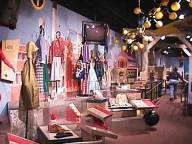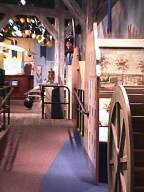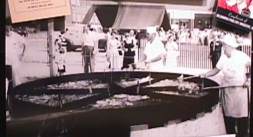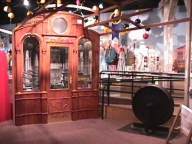FIRST STATE:  Over time the
thirteen colonies in British North America grew more and more
angry at the rules and taxes that England imposed upon them.
Their frustration ultimately led to confrontations and war, but
the road to independence was different for each colony. Less
radical then many of its large neighbors, Delaware chose
independence slowly and reluctantly. Delaware's three delegates
to the Second Continental Congress which produced the Declaration
of Independence, reflected some of the divisions in the small
colony. Caesar
Over time the
thirteen colonies in British North America grew more and more
angry at the rules and taxes that England imposed upon them.
Their frustration ultimately led to confrontations and war, but
the road to independence was different for each colony. Less
radical then many of its large neighbors, Delaware chose
independence slowly and reluctantly. Delaware's three delegates
to the Second Continental Congress which produced the Declaration
of Independence, reflected some of the divisions in the small
colony. Caesar  Rodney and Thomas McKean favored independence
but George Read took a more cautions view in July 1776. It looked
like the vote was going down to a tie with one Delaware delegate
missing. Caesur Rodney lay dying from skin cancer in a distant
town. When it became obvious that his vote was crucial to the
independence, he mounted a horse and rode for days, staggered
into the Congress and voted for independence before collapsing.
Just a year after Caesur Rodney made his famous ride to vote for
independence, the new State of Delaware faced its greatest danger
of the Revolutionary War. Invasion by British forces. In
September 1777, British troops marched into Wilmington and
occupied the city for over a month, capturing Delaware's
government, the state's treasury and all its official papers.
Delawareans learned firsthand, the price of war. It was in the
next section that I learned another trivia. Some of the first
roads in
Rodney and Thomas McKean favored independence
but George Read took a more cautions view in July 1776. It looked
like the vote was going down to a tie with one Delaware delegate
missing. Caesur Rodney lay dying from skin cancer in a distant
town. When it became obvious that his vote was crucial to the
independence, he mounted a horse and rode for days, staggered
into the Congress and voted for independence before collapsing.
Just a year after Caesur Rodney made his famous ride to vote for
independence, the new State of Delaware faced its greatest danger
of the Revolutionary War. Invasion by British forces. In
September 1777, British troops marched into Wilmington and
occupied the city for over a month, capturing Delaware's
government, the state's treasury and all its official papers.
Delawareans learned firsthand, the price of war. It was in the
next section that I learned another trivia. Some of the first
roads in  Delaware were built by private companies. These
companies hired farmers and innkeepers who lived along the road
to collect tolls. Long poles or "pikes" were often
stretched across the road to prevent people from passing without
paying. Only after travelers paid the toll would the toll keeper
raise or "turn the pike", thus the roads were often
referred to as Turnpikes. Frequent users of the road could
purchase passes from the company. It is sad to say that not much
has changed over the years in this area. The New Jersey Turnpike
is still one of the most expensive roads I have ever driven on.
POULTRY: In the early 1900s Americans ate chicken only on special
occasions. That began to change in 1923 when a Dageboro hatchery
accidentally sent Cecile Steele, a Susses County housewife 500
chickens instead of 50 she ordered. She raised the chicks and
sold them for a hefty profit. Thus hatching the modern broiler
chicken industry. Poultry farmers capitalized on Delaware's
temperate climate, feed-producing farms and modern highways that
connected them to larger urban markets.
Delaware were built by private companies. These
companies hired farmers and innkeepers who lived along the road
to collect tolls. Long poles or "pikes" were often
stretched across the road to prevent people from passing without
paying. Only after travelers paid the toll would the toll keeper
raise or "turn the pike", thus the roads were often
referred to as Turnpikes. Frequent users of the road could
purchase passes from the company. It is sad to say that not much
has changed over the years in this area. The New Jersey Turnpike
is still one of the most expensive roads I have ever driven on.
POULTRY: In the early 1900s Americans ate chicken only on special
occasions. That began to change in 1923 when a Dageboro hatchery
accidentally sent Cecile Steele, a Susses County housewife 500
chickens instead of 50 she ordered. She raised the chicks and
sold them for a hefty profit. Thus hatching the modern broiler
chicken industry. Poultry farmers capitalized on Delaware's
temperate climate, feed-producing farms and modern highways that
connected them to larger urban markets.  By the 1930s Delaware led the nation in broiler
production making "a chicken in every pot" a reality.
The industry continues to provide thousands of jobs on farms in
processing plants and in associated industries. In 1948, the
Atlantic and Pacific Tea Co. (A&P) sponsored a contest to
breed the best broilers. From this came the Delaware Chicken
Festival. In 1950 the Mumford Sheet Metal Works in Selbyville
manufactured this ten-foot diameter frying pan, the worlds,
largest, for the contest. After cooking over one hundred tons of
chicken, the festival retired this pan in 1988. Delaware Poultry
Inc., continues the festival to this day. THE CIVIL WAR
YEARS: Caught in the middle, a slave state with a strong
abolitionist presence Delaware
By the 1930s Delaware led the nation in broiler
production making "a chicken in every pot" a reality.
The industry continues to provide thousands of jobs on farms in
processing plants and in associated industries. In 1948, the
Atlantic and Pacific Tea Co. (A&P) sponsored a contest to
breed the best broilers. From this came the Delaware Chicken
Festival. In 1950 the Mumford Sheet Metal Works in Selbyville
manufactured this ten-foot diameter frying pan, the worlds,
largest, for the contest. After cooking over one hundred tons of
chicken, the festival retired this pan in 1988. Delaware Poultry
Inc., continues the festival to this day. THE CIVIL WAR
YEARS: Caught in the middle, a slave state with a strong
abolitionist presence Delaware remained part of the Union. Delawareans'
loyalties, divided between North and South, created tension
throughout the State and shattered families and friendships.
People suspected of supporting the South were jailed, and Union
troops guarded state and national elections. Many young Delaware
men volunteered for Union forces yet a few with strong
secessionist feelings chose to head south to join Confederate
troops. Nearly 1,000 African Americans joined troops for other
states when Delaware refused to sponsor black regiments. After
the Civil war, Delaware refused to ratify the 13th, 14th, and
15th amendments to the U.S. Constitution. In the 1870s Delaware
adopted "Jim Crow" laws that limited the rights and
privileges of African Americans. Those laws forced segregation on
black residents. Exclusion from schools, businesses, certain
employment, places of residence and even areas of recreation
continued until the 1950s. when Delaware began the process of
desegregation.
remained part of the Union. Delawareans'
loyalties, divided between North and South, created tension
throughout the State and shattered families and friendships.
People suspected of supporting the South were jailed, and Union
troops guarded state and national elections. Many young Delaware
men volunteered for Union forces yet a few with strong
secessionist feelings chose to head south to join Confederate
troops. Nearly 1,000 African Americans joined troops for other
states when Delaware refused to sponsor black regiments. After
the Civil war, Delaware refused to ratify the 13th, 14th, and
15th amendments to the U.S. Constitution. In the 1870s Delaware
adopted "Jim Crow" laws that limited the rights and
privileges of African Americans. Those laws forced segregation on
black residents. Exclusion from schools, businesses, certain
employment, places of residence and even areas of recreation
continued until the 1950s. when Delaware began the process of
desegregation.
*** THE END ***

